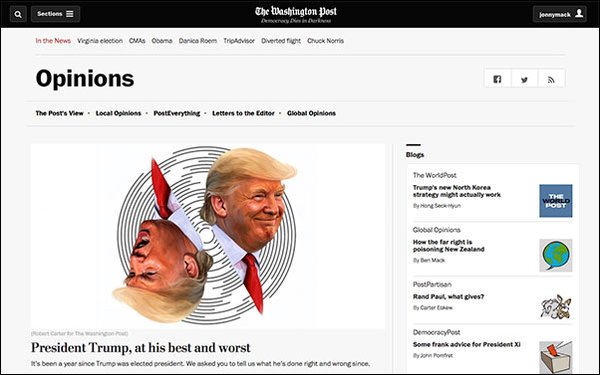'Washington Post' Launches 'Counterpoint' To Opinion Pieces
- by Sara Guaglione , November 9, 2017

The Washington Post is rolling out a new module today to recommend an opinion piece with a different point of view from what a user is currently reading.
Called “Counterpoint,” the feature appears at the bottom of select Opinion pieces, with a headline and link to a story with "a different view on the issue," according to the tagline next to the Counterpoint header.
The process of
tagging content with opposing views is “made easier” by the use of WaPo's AI technology, according to Dr. Sam Han (PhD), director of data science at the
newspaper.
“We will continue to refine our technology and showcase the diversity of our content on external platforms and social media,” Han added.
Fred Hiatt, editorial page editor, stated the Opinion section provides a range of topics from “a variety of viewpoints. We’re excited to make the diversity of this content more prominent for our readers,” he said. “This is one way we can present a range of views that can help our audience be more informed and that hopefully will encourage dialogue.”
advertisement
advertisement
All of WaPo’s news stories carry “The Post Recommends” section below to suggest relevant stories.
The move is a way to expand content and challenge readers' affinity for consuming news from outlets that fit their political leanings.
Opinion sections get readers heated. The New York Times’ hire of conservative policy and politics columnist Bret
Stephens this spring triggered some readers to cancel subscriptions.
Business magazine Forbes shut down its opinion section this month to focus on its network of online contributors. “The need for conventional opinion-style writing has lessened,” Forbes Media vice president of digital news Mark Coatney wrote in an internal memo at the time.
But other publishers are doubling down on the section. In October, NBC News debuted Think, a digital vertical dedicated to commentary, analysis and opinion, while BuzzFeedlaunched an opinion section this summer.
In a memo, BuzzFeed editor-in-chief Ben Smith said the goal is to “address the rapidly changing world and contextualize it in ways that help our readers make sense of what the hell is happening.”


